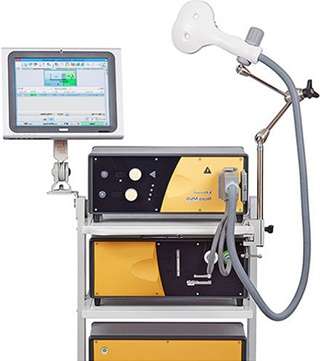New Procedures ‘’R-Tms’’ İn Tinnitus Treatment

With the latest medical treatments, new procedures have been included in the treatment of tinnitus. One of these therapies is r-TMS(repetitive transcranial magnetic stimulation). We carry out new advanced tinnitus diagnosis and treatment procedures in our unit. We successfully perform r-TMS, one of these new treatment procedures in our unit. With intent to ensure an adequate diagnosis, we can also detect the points that create the tinnitus, by means of routine FMRI imaging procedures and other examinations. Our comprehensive study group is as able to provide successful treatments to patients suffering from tinnitus.
Tinnitus is widely observed in society. Although it is said that 1 out of every 15 Americans has tinnitus, the last surveys show that the percentage of such patient in their society is 15%. One or two out of every 15 people in our country is/are thought to suffer from tinnitus, as well.
Many methods have been tried as a tinnitus treatment in the past. However, neither such methods nor the classical medications have produced adequate results. r-TMS is an important treatment for tinnitus. It has a higher success rate than that of the conventional treatments. Alternative therapies applied by the patients themselves give adequate results, as well. In addition, people often heard stereotypical words from doctors, such as "It is not curable, so you have to get used to live with it." The latest treatments and innovations have made such expressions meaningless. Tinnitus has become one of the curable diseases.
Medical advancements in recent years have become a great hope for the solution of tinnitus. r-TMS therapy, one of the new treatment plans and methods, has begun to appear in the latest medical scientific publications.
r-TMS has gained acceptance across the world, after its results have been published in important medical journals. Thus, r-TMS therapy has been included in the medical literature, as the latest device-based treatment. In addition, many drug-based innovations have begun to be used to treat tinnitus in scientific studies.
It has been three years since we have begun to perform this new procedure (r-TMS) in the treatment of tinnitus, based on these new developments in this field. We have achieved positive results from many of our patients. This new procedure has a much higher treatment success compared to that of older classical treatment procedures. We can now enable patients with tinnitus to reach a recovery level, at which they can tolerate or overcome tinnitus. As the leading medical team in the field of otorhinolaryngology in our country, we are able to approach tinnitus this much comprehensively and successfully.
What is the new r-TMS treatment?
 R-TMS is the abbreviated form of repetitive transcranial magnetic stimulation. As the working principle, the magnetic field generated in r-TMS transmits a current to the ear region and brain cells. The magnetic current created with r-TMS regulates the cellular activities of nerve cells in the auditory areas (from the ear to the auditory center in the brain). It should be kept in mind that auditory pathways, as anatomical structures, begin from the ear and extend up to the temporal lobe (their last point in the brain); and that the region called the auditory cortex functions just like a computer's processor and hard disk. When this system is considered as a whole rather than a unidirectional process, and when the required examinations are performed, the problematic areas can be easily identified. Nerve cells extend up to the auditory centers of the brain in sequences called neuron fibers. Many cells come together on each fiber extension, and consequently create these extensions. It is today a well-known scientific fact that nerve cells transmit messages from one cell to another up to the centers in the brain, though an electrical charge of 70 millivolts. Cell damages or impaired activitiesare some of the main causes of tinnitus. Although there are many causes of tinnitus, these types of causes of tinnitus are common. The ability to regulate electrical activities at such impaired points can be ensured with devices called r-TMS. With r-TMS, the electrical activities of the cells in the auditory centers of the brain are regulated, and cells are enabled to return to their normal working order. The chance of success varies from person to person; however, it has been considered to be today's only and newest technological development that allows for achieving high-level success.
R-TMS is the abbreviated form of repetitive transcranial magnetic stimulation. As the working principle, the magnetic field generated in r-TMS transmits a current to the ear region and brain cells. The magnetic current created with r-TMS regulates the cellular activities of nerve cells in the auditory areas (from the ear to the auditory center in the brain). It should be kept in mind that auditory pathways, as anatomical structures, begin from the ear and extend up to the temporal lobe (their last point in the brain); and that the region called the auditory cortex functions just like a computer's processor and hard disk. When this system is considered as a whole rather than a unidirectional process, and when the required examinations are performed, the problematic areas can be easily identified. Nerve cells extend up to the auditory centers of the brain in sequences called neuron fibers. Many cells come together on each fiber extension, and consequently create these extensions. It is today a well-known scientific fact that nerve cells transmit messages from one cell to another up to the centers in the brain, though an electrical charge of 70 millivolts. Cell damages or impaired activitiesare some of the main causes of tinnitus. Although there are many causes of tinnitus, these types of causes of tinnitus are common. The ability to regulate electrical activities at such impaired points can be ensured with devices called r-TMS. With r-TMS, the electrical activities of the cells in the auditory centers of the brain are regulated, and cells are enabled to return to their normal working order. The chance of success varies from person to person; however, it has been considered to be today's only and newest technological development that allows for achieving high-level success.
How is r-TMS treatment carried out?
First the problem causing the tinnitus should be identified. After tinnitus examination and anamnesis, we request our patients to fill out 3 different questionnaires, with intent to have preliminary information about their condition. Among questionnaires, we use THI (Tinnitus Handicap Inventory), VAS (Visual Analogue Scales), and Beck'sDepression Inventory questionnaires before and after treatment. If the doctor decides to carry outa r-TMS therapy to the patient, whose conditions has been identified after the examination stage, the patient has to allocate time for this treatment. The treatment is usually divided into days, and is carried out in 10 successive sessions. There are various ways of administration, depending on the cause, severity and duration of the disease. In our practice, the process (including the examinations) takes 12 to 14 days. Each session takes about 20 to 35 minutes, on average. This procedure is performed while the patient is awake, sitting on a seat. It does not cause aches and pains. Despite being rare, a temporary headache may occur at the application area, due to the interaction of the muscles in the transition zone of the current. The patient may return to work after the application.
How is the mechanism of action and effect of the r-TMS device?
.jpg) It is a device developed as a result of research studies that have taken more than 50 years. After being involved in treatments, the first versions of r-TMS devices have been developed in the course of time, and then have reached high-success levels as today's r-TMS version. The success rate that was 30-40% with the initial studies and the first-version devices is todays reaches 75% with today's latest version r-TMS devices (according to the reports in the medical literature). When the causes of tinnitus are investigated, the auditory pathways should be looked at and investigated as a whole. Auditory pathways are the sensor receptors in the inner ear, the nerve cells that transmit the messages, and the storage area in the auditory center in the brain. As the working principle, it operates based on the magnetic field created in r-TMS. r-TMS messages reach the neurons with disrupted activities in all the auditory pathways and the brain area. A current is transmitted to the ear area and the cells of the auditory center in the brain. This current regulates the functions of the disorganized cells with impaired activities, and reactivates them. It normalizes the functioning of the cells, by reducing the abnormal activity that creates chaos in the functioning of cells. Cells with improved activity become structures that function normally. When these activities turn to normal, the tinnitus diminishes and goes away. The chance of success varies from person to person; however, it has been considered to be today's only and newest technological development that allows for achieving high-level success.
It is a device developed as a result of research studies that have taken more than 50 years. After being involved in treatments, the first versions of r-TMS devices have been developed in the course of time, and then have reached high-success levels as today's r-TMS version. The success rate that was 30-40% with the initial studies and the first-version devices is todays reaches 75% with today's latest version r-TMS devices (according to the reports in the medical literature). When the causes of tinnitus are investigated, the auditory pathways should be looked at and investigated as a whole. Auditory pathways are the sensor receptors in the inner ear, the nerve cells that transmit the messages, and the storage area in the auditory center in the brain. As the working principle, it operates based on the magnetic field created in r-TMS. r-TMS messages reach the neurons with disrupted activities in all the auditory pathways and the brain area. A current is transmitted to the ear area and the cells of the auditory center in the brain. This current regulates the functions of the disorganized cells with impaired activities, and reactivates them. It normalizes the functioning of the cells, by reducing the abnormal activity that creates chaos in the functioning of cells. Cells with improved activity become structures that function normally. When these activities turn to normal, the tinnitus diminishes and goes away. The chance of success varies from person to person; however, it has been considered to be today's only and newest technological development that allows for achieving high-level success.
Are There Side Effect of the r-TMS Procedure?
There is no side effect of the r-TMS procedure in terms of the both body and brain. Multifaceted medical studies on side effects have been conducted. No side effects have been observed. As a matter of fact, it is a device that fulfills and recovers the impaired activities. Such useful magnetic currents different in nature are harmless to the body. It can be safely used in pregnant women and patients with important diseases such as liver, kidney diseases. There are practical restrictions in some cases, such as the cases of patients with brain aneurysm, who use metal clips (not plastic clips) for it, patients with epilepsy, patients bearing metal stents in the neck or vein, patients bearing metallic implants in their ears and eyes (such as bionic ear), patients having a shrapnel piece or bullet in their heads, patients with facial tattoos made with metallic or magnetically sensitive ink, and patients bearing other metal apparatus implanted on or inside their head.







